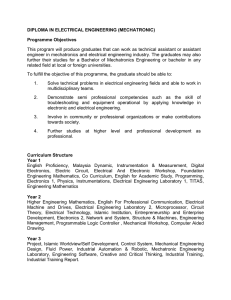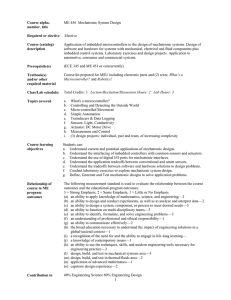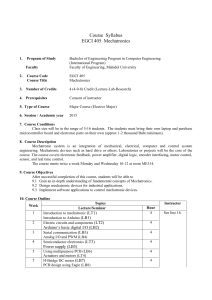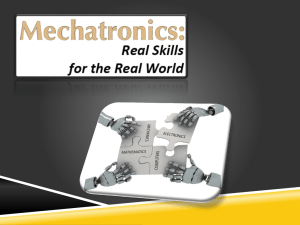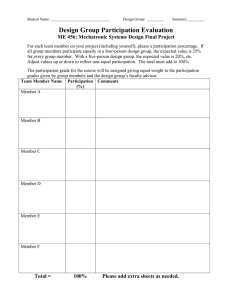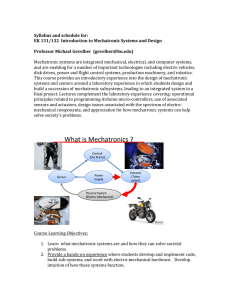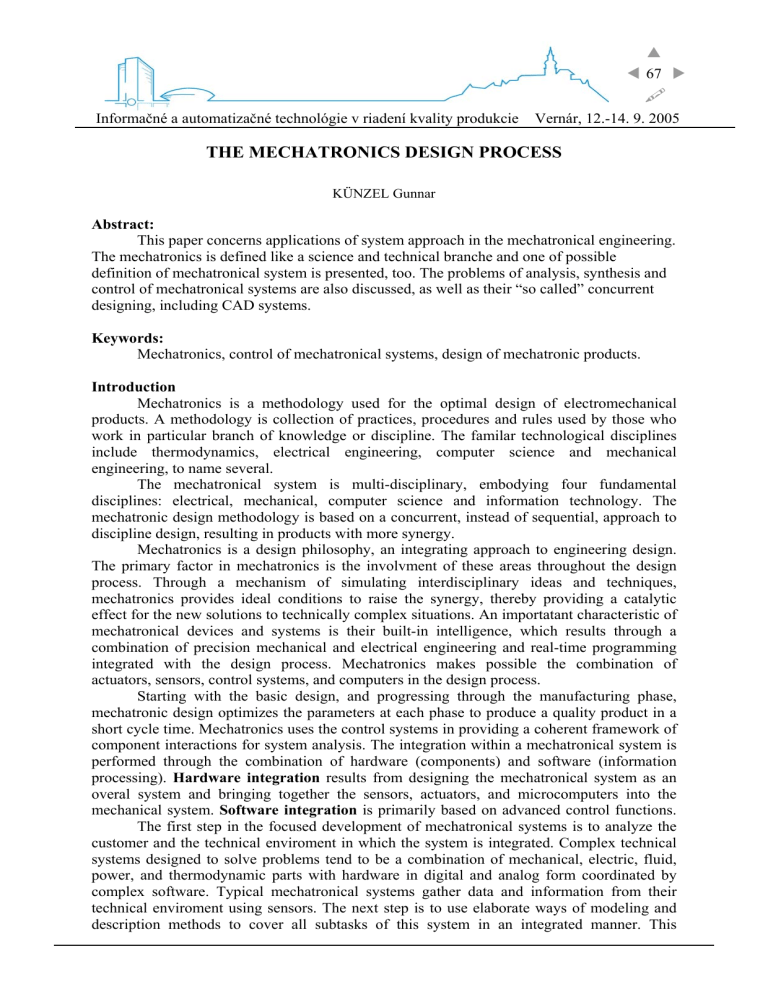
S W 67 X Informačné a automatizačné technológie v riadení kvality produkcie Vernár, 12.-14. 9. 2005 THE MECHATRONICS DESIGN PROCESS KÜNZEL Gunnar Abstract: This paper concerns applications of system approach in the mechatronical engineering. The mechatronics is defined like a science and technical branche and one of possible definition of mechatronical system is presented, too. The problems of analysis, synthesis and control of mechatronical systems are also discussed, as well as their “so called” concurrent designing, including CAD systems. Keywords: Mechatronics, control of mechatronical systems, design of mechatronic products. Introduction Mechatronics is a methodology used for the optimal design of electromechanical products. A methodology is collection of practices, procedures and rules used by those who work in particular branch of knowledge or discipline. The familar technological disciplines include thermodynamics, electrical engineering, computer science and mechanical engineering, to name several. The mechatronical system is multi-disciplinary, embodying four fundamental disciplines: electrical, mechanical, computer science and information technology. The mechatronic design methodology is based on a concurrent, instead of sequential, approach to discipline design, resulting in products with more synergy. Mechatronics is a design philosophy, an integrating approach to engineering design. The primary factor in mechatronics is the involvment of these areas throughout the design process. Through a mechanism of simulating interdisciplinary ideas and techniques, mechatronics provides ideal conditions to raise the synergy, thereby providing a catalytic effect for the new solutions to technically complex situations. An importatant characteristic of mechatronical devices and systems is their built-in intelligence, which results through a combination of precision mechanical and electrical engineering and real-time programming integrated with the design process. Mechatronics makes possible the combination of actuators, sensors, control systems, and computers in the design process. Starting with the basic design, and progressing through the manufacturing phase, mechatronic design optimizes the parameters at each phase to produce a quality product in a short cycle time. Mechatronics uses the control systems in providing a coherent framework of component interactions for system analysis. The integration within a mechatronical system is performed through the combination of hardware (components) and software (information processing). Hardware integration results from designing the mechatronical system as an overal system and bringing together the sensors, actuators, and microcomputers into the mechanical system. Software integration is primarily based on advanced control functions. The first step in the focused development of mechatronical systems is to analyze the customer and the technical enviroment in which the system is integrated. Complex technical systems designed to solve problems tend to be a combination of mechanical, electric, fluid, power, and thermodynamic parts with hardware in digital and analog form coordinated by complex software. Typical mechatronical systems gather data and information from their technical enviroment using sensors. The next step is to use elaborate ways of modeling and description methods to cover all subtasks of this system in an integrated manner. This S W 68 X Informačné a automatizačné technológie v riadení kvality produkcie Vernár, 12.-14. 9. 2005 includes an effective description of necessary interfaces between subsystems at an early stage. The data are processed and interpreted, leading to action carried out by actuators. Mechatronical systems result in shorter developmental cycles, lower costs, and higher quality. They also provide additional influence through the acquisition of information from the process. Mechatronic design supports the concepts of concurrent engineering. In the designing of a mechatronic product, it is necessary that the knowledge and required information be coordinated among different expert groups. Concurrent engineering is a design approach in which the design of a product and manufacture of a product are merged in a special way. Traditional barriers between design and manufacturing are removed. It has been influenced partly by the recognition that many of the high costs in manufacturing are decided at the product design stage itself. Even during the design stage, it is involved with customer perception, market analysis, optimised performance, life cycle performance, quality, reliability, and sales. Product design and planning take place concurrently. The total philosophy of concurrent engineering in the organization is well suited for team-oriented project management, with emphasis on collective decision making. Successful implementation of concurrent engineering is possible by coordinating adequate exchange of information and dealing with organization barriers to cross-functional cooperation. Due to the influence of concurrent engineering, traditional barriers between design and manufacturing have decreased; however, the lack of a common interface language has made the information exchange in concurrent engineering difficult. A mechatronic product can achieve impressive results if it is effectively integrated with the concurrent engineering management strategy. The benefits that accrue are grater productivity, higher quality, and production reliability by the incorporation of intelligent, selfcorrecting sensory feedback systems. The integration of sensors and control systems in a complex system reduces capital expenses, maintains a high degree of flexibility, and results in a higher percentage of machine utilization. In order to implement a mechatronic concurrent engineering system that can achieve these objectives, the organization must start with a longrange plan that can také into accounts tomorrow’s changing needs in process, data functions, control, and integration tools. The mechatronic design methodology is concerned not only with producing highquality products but with maintaining them as well, an area referred to as life cycle design. Several important life cycle factors are described below. • Delivery: Time, cost, and medium • Reliability: Failure rate, materials, and tolerances. • Maintainability: Modular design. • Serviceability: On board diagnostics, prognostics, and modular design. • Upgradeability: Future compatibility with current designs. • Disposability: Recycling and disposal of hazardous materials We will not dwell on life cycle factors except to point out that the conventional design for life cycle approach begins with a product after it has been designed and manufactured. In the mechatronic design approach, life cycle factors are included during the product design stages, resulting in products that are designed from conception to retirement. The mechatronic design process is presented in Fig. 1. S W 69 X Informačné a automatizačné technológie v riadení kvality produkcie Vernár, 12.-14. 9. 2005 Fig. 1 Mechatronic design process The mechatronic design process consists of three phases: modeling and simulation, prototyping and deployment. All modeling, whether based on first principles (basic equations) or the more detailed physics, should be modular in structure. A first principle model is a simple model that captures some of the fundamental behavior of a subsystem. A detailed model is an extension of the first principle model providing more function and accuracy than the first-level model. Complex models may be created by connecting the modules, or blocks, together. Each block represents a subsystem that corresponds to some physically of functionally realizable operations that can be encapsulated into a block with input/output limited to input signals, parameters, and output signals. Of course this limitation may not always be possible or desirable; however, its use will produce modular subsystem blocks that can be easily maintained, exercised independently, substituted for one another (first principle blocks substituted for detailed blocks and vice versa), and reused in other applications. Following deployment, the life cycle functions begin, and information from these functions should be made available for upgrades to the product. Because of their modularity, mechatronical systems are well suited for applications that require reconfigurations. Such products can be reconfigured either during the design stage by substituting various subsystem modules or during the life span of the products. Since many of the steps in the mechatronic design processes rely on computer-based tasks such as information. Fusion, management, and design testing, and efficient computer-aided prototyping environment is essential. Some of the important features of such an environment are listed and described below. S W 70 X Informačné a automatizačné technológie v riadení kvality produkcie • • • • • • • • Vernár, 12.-14. 9. 2005 Modeling: Block diagram or visual interface for creating intuitively understandable behavioral models of physical or abstract phenomena. The ability to encapsulate complexity and maintain several levels of submodel complexity is useful. Simulation: Numerical methods for solving models containing differential, discrete, hybrid, partial, and implicit nonlinear se well as linear equations. Must have a lock for real-time operation and be capable of executing faster than real time. Project Management: Database for maintaining project information and submodels for eventual reuse. Design: Numerical methods for constrained optimization of performance functions based on model parameters and signals. Monte Carlo type capability is also desirable. Analysis: Numerical methods for frequency domain, time domain, and complex domain design. Real-Time Interface: A plug-in card is used to replace part of the model with actual hardware by interfacing to it with actuators and sensors. This is called a hardware-inthe-loop simulation or rapid prototyping and must be executed in real time.. Code Generator: To produce efficient high-level source code from the block diagram or visual modeling interface. The control code will be compiled and used on the embedded processor. The language is usually C. Embedded Processor Interface: The embedded processor resides in the final products, and this feature provides communication between it and the computer-aided prototyping environment. This is called a full system prototype. Because no single model can ever flawlessly reproduce reality, there will always be error between the behavior of a product model and the actual products. These errors, referred to as unmodeled errors, are the reason why so many model-based designs fail when deployed top the product. The mechatronic design approach also uses a model-based approach, relying heavily on modeling and simulation; however, unmodeled errors are accounted for in the prototyping step. Their effects are absorbed into the design, which significantly raiser the probability of successful product deployment. In the prototyping step many of the noncomputer subsystems of the model are replaced with actual hardware. Sensors and actuators provide interface signals necessary to connect the hardware subsystems back to the model. The resulting model is part mathematical and par real. Because the real part of the model inherently evolves in real time and the mathematical part evolves in simulated time, it is essential that the two parts be synchronized. This process of fusing and synchronizing model, sensor, and actuator information is called real-time interfacing or hardware-in-the-loop simulation and is and essential ingredient in the modeling an simulating environment. Advanced approaches in mechatronics In addition to influencing the way the products are designed, recent developments in mechatronics are also creating opportunities in intelligent manufacturing. In order to produce high-quality products at low life cycle costs, many manufacturing plants have been reducing their workforce. As a result, the reduced workforce has to cope with additional tasks and responsibilities. And there is a broader area of control for plant management. This trend has significantly influenced the mechatronic field, especially in the area of sensor-based manufacturing. It has created opportunities for the use of intelligent autonomous inspection systems as well as intelligent decision-making systems that perform tasks automatically, without human intervention, by adapting to the changes in the environment. S W 71 X Informačné a automatizačné technológie v riadení kvality produkcie Vernár, 12.-14. 9. 2005 Model-based monitoring using intelligent sensors is an important technology holding much promise for improving manufacturing productivity and quality. In model-based monitoring the model is used to represent the ideal behavior of the structure. It is driven with the same inputs used for the process. The difference between the model output and the actual process output signals provides a concise mechanism for incorporating diagnostics, an attractive alternative to empirical rule-based decisions systems Monitoring systems can also be used to maintain machine and process performance during the manufacturing process. Fig. 2 presents a generic diagram of an intelligent modelbased manufacturing system. Fig. 2 Model-based monitoring system In Fig. 2 the monitoring output indicates the status of the monitoring process. The controller applies commands to the process such that various sensed values, related to machine and/or process performance, are maintained, or regulated, at desired values. Mechatronic technology used in manufacturing will impact new equipment as well as some retrofit applications. Most of the obstacles that are encountered in retrofit applications are due to hardware incompatibility and closed software structures. Computerized Machining Centers and Programmable Logic Controllers often utilize proprietary hardware, making integration between different systems difficult. The closed structure of the real-time process control, often found in older machinery, also presents implementation problems. The development of modular, open-architecture machine controllers, Fig. 3 can provide improvements to the existing system and enhance flexibility. The growth of openarchitecture systems for machine tool control will result in greater utilization of real-time process monitoring and control modules. This trend is also responsible for accelerating the use of systems will require a system perspective on manufacturing problems. A system approach which considers various solution alternatives for obtaining desired production performance will likely employ mechatronic technology. Examples of mechatronical systems for industrial use are found in many areas. Mechatronic monitoring systems have been applied to products such as aircraft, machine tools, and automobiles. These systems are designed to measure plant parameters such as compliances and inertias, plant states such as current and velocity, and production states such as force and wear. S W 72 X Informačné a automatizačné technológie v riadení kvality produkcie Vernár, 12.-14. 9. 2005 Fig. 3 Mechatronic system with open-architecture platform • • • • • • • • • Some other noteworthy mechatronic applications are listed below: Autonomous production cells with image-based object recognition. Monitoring and control of the welding process (currently under research at the European Center of Mechatronics). Mechatronical systems with off-line programming that automatically program a robot after receiving CAD data. Integrated supervisory systems with multi-process control capability and shared databases from the CD drawings. Flexible manufacturing systems with off- and on-line programming Biorobotics, which utilize the bio functions for applications in environmental control. Endoscopic and orthopedic surgery. Magnetically levitated vehicles. Robotics in nuclear inspection and space applications. Numerical computation, simulation, computer-aided design and experimental validation are important technologies that must be considered when evaluating the feasibility of complex mechatronical systems. Other technologies include artificial intelligence, expert systems, fuzzy logic, and neural networks. The usefulness of these technologies is expected to be at the higher levels of the control hierarchy in machining processes. Conclusion Successful mechatronic design can lead to products that are extremely attractive to the consumer in quality cost-effectiveness. Conversely, products designed in the more traditional, sequential manner appear old-fashioned, have limited capabilities, and lack consumer appeal. From the product design point of view, successful design is concerned with utilizing specialist designers, together with representatives from finance, manufacturing, public relations, and marketing, in team efforts to produce novel, high-technology products with previously unattainable specifications. S W 73 X Informačné a automatizačné technológie v riadení kvality produkcie Vernár, 12.-14. 9. 2005 References VALÁŠEK, M. Mechatronika, ČVUT FS, Praha, 1995 NESCULESCU, D. S. Mechatronics, Amazon.com Books, New York, 1997 BOLTON, W. Mechatronics, Amazon.com Books, New York, 2003 NANUA, S. System Approach to Computer Integrated Design of Manufacturing, New York, J. Willey & Sons, 1990 Ing. Gunnar Künzel Czech University of Agriculture in Prague, Technical faculty, Dept. of Electroengineering and Automation Kamycka str. 129, 165 21 Prague 6 – Suchdol, Czech republic kunzel@tf.czu.cz, tel.: +4202 2438 3194
